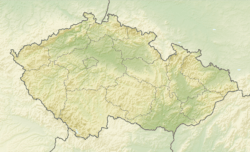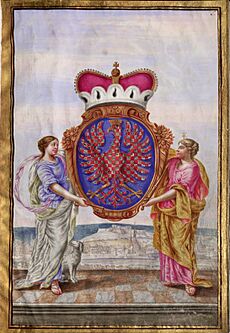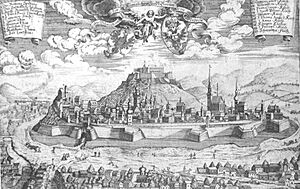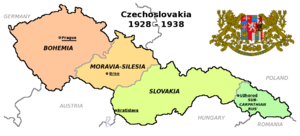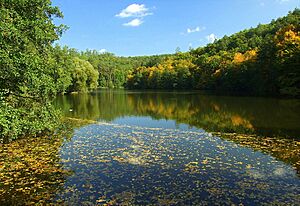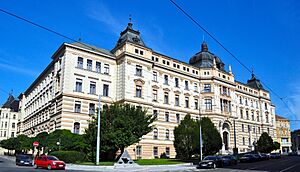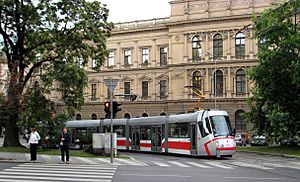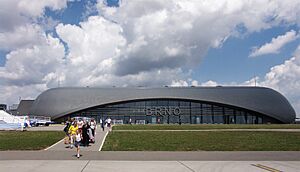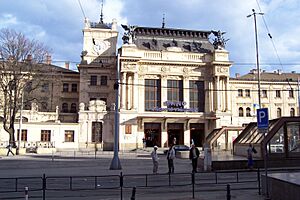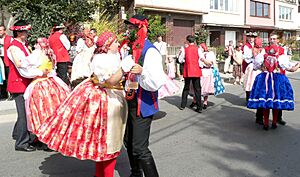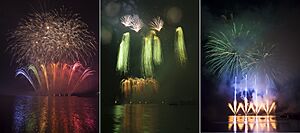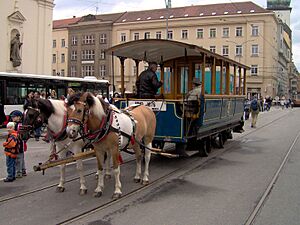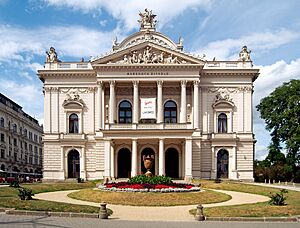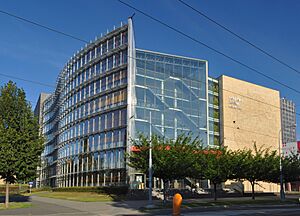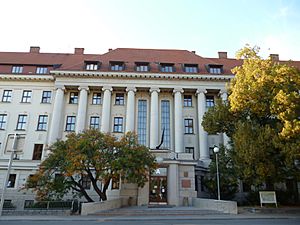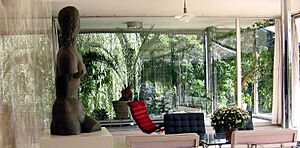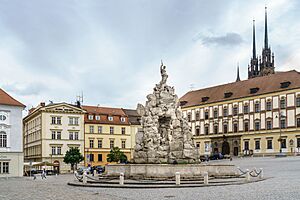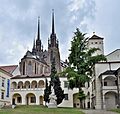Brno facts for kids
Quick facts for kids
Brno
|
|||||
|---|---|---|---|---|---|
|
Statutory city
|
|||||

Clockwise from top: Liberty Square; Lužánky Park; Ignis Brunensis; Špilberk Castle; Brno Exhibition Centre; Villa Tugendhat; and Cathedral of St. Peter and Paul
|
|||||
|
|||||
| Country | |||||
| Region | South Moravian | ||||
| District | Brno-City | ||||
| Founded | c. 1000 | ||||
| Area | |||||
| • Statutory city | 230.18 km2 (88.87 sq mi) | ||||
| • Land | 225.71 km2 (87.15 sq mi) | ||||
| • Water | 4.47 km2 (1.73 sq mi) | ||||
| • Metro | 3,170 km2 (1,220 sq mi) | ||||
| Elevation | 237 m (778 ft) | ||||
| Highest elevation | 497 m (1,631 ft) | ||||
| Lowest elevation | 190 m (620 ft) | ||||
| Population
(2024-01-01)
|
|||||
| • Statutory city | 400,566 | ||||
| • Density | 1,740.23/km2 (4,507.17/sq mi) | ||||
| • Metro | 696,413 | ||||
| Time zone | UTC+1 (CET) | ||||
| • Summer (DST) | UTC+2 (CEST) | ||||
| Postal code |
600 00 – 650 00
|
||||
Brno (pronounced BUR-noh) is a big city in the South Moravian Region of the Czech Republic. It sits where the Svitava and Svratka rivers meet. With about 400,000 people, Brno is the second-largest city in the Czech Republic, after the capital, Prague. It's also one of the 100 biggest cities in the European Union. The larger area around Brno has about 720,000 residents.
Brno used to be the capital of Moravia, a historical land. Today, it's a major center for law in the Czech Republic. Many important courts, like the Constitutional Court and the Supreme Court, are located here. Brno is also a big place for learning, with 13 universities and colleges and about 62,000 students.
The Brno Exhibition Centre is one of Europe's largest places for shows and trade fairs. It opened in 1928. Brno is also famous for exciting motorbike races at the Masaryk Circuit, a tradition that started in 1930. Another cool event is Ignis Brunensis, an international fireworks competition that brings in thousands of visitors.
Some of the most popular places to visit in Brno include Špilberk Castle, an old fortress, and the Cathedral of Saints Peter and Paul. These medieval buildings stand tall over the city. Another old castle nearby is Veveří Castle by the Brno Reservoir. The Villa Tugendhat is a famous modern building that became a UNESCO World Heritage Site in 2001. Near the city, you can also explore the amazing caves of the Moravian Karst. Brno is known as a "City of Music" by UNESCO since 2017.
Contents
- What's in a Name?
- A Look Back: Brno's History
- Brno's Location and Climate
- How Brno is Governed
- People of Brno
- Brno's Economy
- Getting Around Brno
- Brno's Culture and Fun
- Education in Brno
- Sports in Brno
- Amazing Sights of Brno
- Famous People from Brno
- Brno's International Connections
- Images for kids
- See also
What's in a Name?
The name Brno has a debated origin. It might come from an old Czech word, brnie, meaning 'muddy' or 'swampy'. Another idea is that it comes from a Slavic word meaning 'to armor' or 'to fortify'. Some even think it's from an old Celtic language, similar to the Welsh word bryn for hill.
People in Brno have used other names for the city throughout history. These include Brünn in German, Brin in Yiddish, and Bruna in Latin.
Did you know that the asteroid 2889 Brno is named after the city? Also, the famous Bren light machine gun used in World War II got its name from Brno and Enfield (a place in London).
A Look Back: Brno's History

People have lived in the Brno area since ancient times. The city's direct beginning was a fortified settlement from the Great Moravian Empire, used until the early 11th century.
In the early 11th century, Brno became a castle town for a prince from the House of Přemyslid. It was one of the main centers of Moravia. The first mention of Brno was in a text from 1091, when a Bohemian king attacked his brother at Brno castle.
Moravia was later divided into three parts, each with its own ruler. Brno, along with Olomouc and Znojmo, was a "capital" of one of these parts. Moravia eventually reunited to form the Margraviate of Moravia. For a long time, Brno and Olomouc shared power as important cities. Brno was the official home of the Moravian Margraves (rulers).
In 1243, Brno was officially recognized as a royal city by the King. In 1324, Queen Elisabeth Richeza of Poland founded the Basilica of the Assumption of Our Lady, where she is now buried. In the 14th century, Brno became a key place for Moravian meetings where important decisions were made. Špilberk Castle was the main home for the Margraves of Moravia. Brno was attacked by the Hussites in 1428 and 1430, but they failed to capture the city.
Brno in the 17th Century
During the Thirty Years' War, in 1641, the Holy Roman Emperor decided to move the main government offices from Olomouc to Brno. This was because Olomouc was a target for Swedish armies. In 1642, Olomouc surrendered to the Swedes. But Brno, led by Jean-Louis Raduit de Souches, successfully defended itself from the Swedes in 1645. Because of this, Brno became the only capital of Moravia after the war ended in 1648. This was confirmed by later emperors.
In the 17th century, Špilberk Castle was rebuilt into a huge fortress. In 1742, the Prussian Army tried to capture Brno, but they also failed. In 1777, the bishopric of Brno was created.
The 19th Century and New Inventions
In December 1805, the famous Battle of Austerlitz happened near Brno. The French Emperor Napoleon Bonaparte stayed in Brno several times during this period.
In 1839, the first train arrived in Brno from Vienna. This was the start of train travel in what is now the Czech Republic. From 1859 to 1864, most of the city's old walls were taken down. In 1869, a horsecar service started in Brno, which was the first tram service in the Czech Republic.
Gregor Mendel, a famous scientist, did his important experiments on genetics while he was a monk at St. Thomas's Abbey in Brno in the 1850s.
20th Century and Modern Brno
Around 1900, the central part of Brno mostly had German-speaking people, while the areas around it were mostly Czech-speaking. Life in the city was bilingual, meaning people spoke both languages.
In 1919, after World War I, many nearby towns and villages joined Brno, creating "Greater Brno." This made the city much larger and increased its Czech-speaking population. Before this, Brno had about 130,000 people, and after, it grew to about 222,000.
During the German occupation from 1939 to 1945, all Czech universities were closed. The Faculty of Law became a headquarters for the Gestapo (secret police), and a student dorm was used as a prison. Many people were imprisoned and tortured there.
Between 1941 and 1942, over 10,000 Jewish people from Brno were sent to concentration camps. Only about 1,000 of them returned after the war.

Brno's factories and city center were bombed by the Allies between 1944 and 1945. These attacks killed about 1,200 people and destroyed many buildings. After the war ended in 1945, many German residents were expelled from Brno. In the "Brno death march," about 27,000 German people were forced to walk to the Austrian border.
After World War II, Brno stopped being the capital of Moravia. Since then, it has been the main city of the South Moravian Region. In the 1960s and 1970s, many large apartment buildings were built. After 1989, Brno's economy changed from mainly industry to services, and it became a big center for IT (Information Technology) in the Czech Republic.
Brno's Location and Climate
Brno is in the southeastern part of the Czech Republic. It's located where the Svitava and Svratka rivers meet. Several smaller streams also flow through the city. The Svratka River runs for about 29 km through Brno, and the Svitava River for about 13 km. Brno has always been an important crossroads for trade routes connecting northern and southern Europe. It's about 110 km from Vienna, Austria.
Brno is about 21.5 km wide from east to west and covers an area of 230 square kilometers. Inside the city, there's the Brno Reservoir, several ponds, and other bodies of water. Forests cover about 28% of the city's area.
Brno has a moderate climate because it's located between highlands and lowlands. Compared to other cities in the country, Brno has very good air quality. This is because of good natural air circulation. The city has never had severe storms or other major natural disasters.
The average temperature in Brno is 9.4°C. It gets about 505 mm of rain each year. The city enjoys about 1,771 hours of sunshine annually. The highest point in the city is Kopeček Hill, which is 479 meters tall.
How Brno is Governed
Brno is a "statutory city," meaning it has special self-governing powers. It's divided into 29 city districts. The main governing body is the Brno City Assembly. The city is led by the lord mayor, who represents Brno. As of 2021, the lord mayor is Markéta Vaňková.
The city itself forms its own district, the Brno-City District. This district is surrounded by the Brno-Country District. The city districts of Brno vary a lot in size and population. For example, Brno-Centre has over 91,000 residents, while Brno-Ořešín and Brno-Útěchov have only about 500.
Brno is home to the highest courts in the Czech legal system. This includes the Supreme Court, the Supreme Administrative Court, and the Constitutional Court.
People of Brno
| Historical population | ||
|---|---|---|
| Year | Pop. | ±% |
| 1869 | 104,977 | — |
| 1880 | 120,122 | +14.4% |
| 1890 | 145,782 | +21.4% |
| 1900 | 176,645 | +21.2% |
| 1910 | 216,709 | +22.7% |
| 1921 | 237,659 | +9.7% |
| 1930 | 283,972 | +19.5% |
| 1950 | 299,099 | +5.3% |
| 1961 | 324,173 | +8.4% |
| 1970 | 344,218 | +6.2% |
| 1980 | 371,463 | +7.9% |
| 1991 | 388,296 | +4.5% |
| 2001 | 376,172 | −3.1% |
| 2011 | 385,913 | +2.6% |
| 2021 | 398,510 | +3.3% |
| Source: Censuses | ||
In 2021, Brno had 398,510 people. Most people identified as Czechs (51.6%) or Moravians (18.7%). Other groups include Slovaks, Ukrainians, and Vietnamese.
Brno's population grew the most in the 19th century during the Industrial Revolution. It also saw a big jump in 1919 when many surrounding towns joined the city.
Brno's Economy
Since 1990, Brno's economy has changed a lot. Before, it was mostly about engineering companies. Now, it focuses more on light industry, shipping, and services. The city has become very important for software development. Many foreign and Czech technology companies have set up offices here.
Some big companies in Brno include Gen Digital (known for AVG Technologies), Kyndryl, AT&T, Honeywell, Siemens, and Red Hat.
Brno is also growing in science, research, and education. Organizations like the South Moravian Innovation Centre help new ideas and businesses grow.
Getting Around Brno
Brno has a great public transport system. It includes 12 tram lines, 14 trolleybus lines (the biggest network in the Czech Republic), and almost 40 day and 11 night bus lines. Trams, called šaliny by locals, first appeared in 1869 as horse-drawn trams. This was the first tram service in the Czech Republic.
The public transport system connects Brno with nearby towns. The main operator is the Brno City Transport Company. They even run a ferry on the Brno Dam Lake for fun!
Train travel started in Brno in 1839 with a line to Vienna. Today, Brno is a major train hub. The main railway station is very busy, with about 50,000 passengers daily.
Brno is also a crossroads for international roads. Two major motorways, the D1 (to Ostrava and Prague) and the D2 (to Bratislava), pass by the city. The D52 motorway leads to Vienna. The city is also building a large ring road to help with traffic.
For air travel, Brno has two airports. Brno–Tuřany Airport is the public international airport. It's also a base for police helicopters. Medlánky Airport is a smaller airport mainly used for fun activities like flying hot air balloons or gliders.
Cycling is popular in Brno because the land is mostly flat. There are about 38 km of cycling and roller skating paths, and more are being built. A long bikeway also connects Brno to Vienna.
Brno's Culture and Fun
Brno is a lively university city with many museums, theaters, and cultural places. It also hosts many festivals and events. Since the 1990s, Brno has seen a "cultural rebirth." Old buildings are being fixed up, and new exhibitions and shows are happening.
Even though it's a city, some districts still celebrate traditional Moravian folklore. This includes folk festivals with special costumes, Moravian wines, and folk music and dances.
Hantec is a unique slang language that started in Brno.
Festivals in Brno
The biggest festival in Brno is the fireworks competition, Ignis Brunensis (meaning "Flame of Brno"). It happens every June and is part of the "Brno – City in the Centre of Europe" festival. It's the biggest fireworks show in Central Europe, attracting hundreds of thousands of visitors.
The international film festival Cinema Mundi shows about 60 films that are competing for an Oscar.
Theatre World Brno is another international festival where Brno theaters and the city center host about 100 performances by groups from the Czech Republic and other countries. Other festivals include the International Music Festival Brno and the Summer Shakespeare Festival.
Every September, Brno has a wine festival called Slavnosti vína to celebrate the grape harvest.
Theaters in Brno
Brno has a long history of theater. The Reduta Theatre is the oldest theater building in Central Europe. Plays probably started there in the 1660s. In 1767, Mozart performed there with his older sister. The theater's Mozart Hall is named after him.
The National Theatre of Brno (NdB) is the main producer of opera, drama, and ballet in the city. It owns the Mahen Theatre, built in 1882, the Janáček Theatre, built in 1965, and the Reduta Theatre. The famous composer Leoš Janáček is also connected to the National Theatre of Brno. The Mahen Theatre was the first theater in Europe to be lit by Thomas Edison's electric light bulbs! Edison even came to Brno in 1911 to see it.
The Brno City Theatre is very popular, and its shows are usually sold out. They also perform abroad about 150 times a year.
There are also smaller theaters in Brno, like the Bolek Polivka Theatre and the Goose on a String Theatre.
Local Legends
Brno has some cool legends! One of the most famous is the Legend of the Brno Dragon. People believed a scary creature was bothering the city. They called it a dragon because they had never seen anything like it. A clever citizen finally killed the "dragon" by tricking it into eating a carcass filled with lime. It turns out the "dragon" was actually a crocodile! Its preserved body is now on display at the entrance of the Old Town Hall. You'll see crocodile and dragon designs all over Brno.
Next to the crocodile at the Old Town Hall, you'll find a wagon wheel. This is part of another legend. A local man bet that he could cut down a tree 50 miles away, make a wheel from it, and roll it to Brno all in one day. People thought it was impossible without magic, so they believed he got help from the devil.
Another legend is about the Swedish army attacking Brno in 1645. The Swedish general said he would leave if his army hadn't won by noon. The bell ringer at Petrov Cathedral tricked him by ringing the bell an hour early, at 11 o'clock. The general kept his word and left! To remember this, the bell at Petrov Cathedral still rings for noon at 11 o'clock every day. The Brno astronomical clock also releases a glass ball as a souvenir at this time.
Museums, Libraries, and Galleries
The most important museum in Brno is the Moravian Museum. It's the largest museum in Moravia and the second largest in the Czech Republic, with over 6 million items! The biggest public library is the Moravian Library, which has about 4 million books. The Moravian Gallery is the largest art gallery in Moravia. One part of the Moravian Museum, the Anthropos Pavilion, teaches about the oldest history of humankind.
Brno also has a Technical Museum, which is the largest of its kind in Moravia. It shows how science and technology have advanced, with cool models and restored machines.
Education in Brno
In 2019, about 62,000 students were studying at universities and colleges in Brno. The city is also home to many research centers.
Masaryk University is the largest university in Brno, with over 40,000 students. It has nine different faculties (departments).
The Brno University of Technology was founded in 1899 and is one of the biggest technical universities in the Czech Republic, with over 20,000 students.
Mendel University is named after Gregor Mendel, who developed his amazing ideas about genetics in Brno. It has about 10,000 students.
The Janáček Academy of Music and Performing Arts, named after Leoš Janáček, teaches music and drama.
Sports in Brno
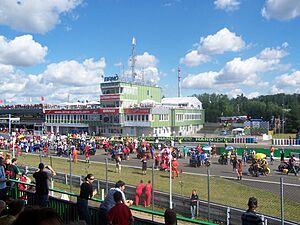
Brno is famous for motor racing. The Masaryk Circuit has hosted the Moto GP championship since 1965. The annual Czech Republic motorcycle Grand Prix is the most famous motor race in the Czech Republic.
Cycling is also very popular in Brno. The velodrome in Brno is one of the oldest cycling tracks in the world. Brno has hosted major cycling championships.
Brno was a host city for the 2010 FIBA World Championship for Women in basketball, where the Czech team won silver!
Many sports clubs represent Brno in different leagues. These include FC Zbrojovka Brno (football), HC Kometa Brno (ice hockey), and several baseball teams like Draci Brno (Brno Dragons). Famous tennis players like Barbora Krejčíková and Lucie Šafářová are from Brno.
Amazing Sights of Brno
Brno has hundreds of historical places to see! One of them, Villa Tugendhat, is a World Heritage Site by UNESCO. Eight other monuments are listed as national cultural heritage sites. Most of Brno's main sights are in the historic city center. Brno has the third largest historic preservation zone in the Czech Republic.
Špilberk Castle, built in the 13th century, was once a royal castle. Later, it became a strong fortress and a feared prison. Today, it's one of the city's main attractions.
Another important landmark is the Cathedral of St. Peter and Paul. It was built in the 14th and 15th centuries on the site of an older chapel. Its two tall, pointed towers were finished in 1909. The other large castle near the city is Veveří Castle.
The Abbey of Saint Thomas is where Gregor Mendel did his famous experiments that led to the science of genetics. The Church of Saint Tomas holds the tomb of its founder. The Basilica of the Assumption of Our Lady holds the grave of Queen Elisabeth Richeza. The Church of Saint James is one of the most beautiful Gothic churches in Brno.
The Brno Ossuary is the second largest ossuary (a place where bones are stored) in Europe. Another ossuary is the Capuchin crypt, which has mummies of monks and other important people. The Labyrinth under Zelný trh (meaning "Cabbage Market") is a system of old underground tunnels and cellars that are now open to the public. These were used for storing food and wine, and as shelters during wars.
Brno has a modern Synagogue and the largest Jewish cemetery in Moravia. A Jewish community has lived in Brno since the 13th century. The synagogue was built between 1934 and 1936. Brno also has the only Czech mosque, built in 1998.
Between the two world wars, Brno saw a lot of new building. Many modern and functionalist buildings were built. The most famous is Villa Tugendhat, designed by architect Ludwig Mies van der Rohe in the 1920s. It became a World Heritage Site in 2001. Other functionalist buildings include the Avion Hotel and Morava Palace. The Brno Exhibition Centre is a major attraction for business visitors, hosting many trade fairs.
Lužánky is the oldest public park in the Czech Republic, created in the late 18th century. Denis Gardens were the first public park in the Czech Republic started by public authorities. Špilberk Park is also a national cultural sight.
One of Brno's newer attractions is the Brno astronomical clock. The AZ Tower, opened in 2013, is the tallest building in the Czech Republic, standing 111 meters tall.
Famous People from Brno
- Gregor Mendel (1822–1884), scientist
- Ernst Mach (1838–1916), physicist and philosopher
- Adolf Loos (1870–1933), architect
- Erich Wolfgang Korngold (1897–1957), composer
- Hugo Haas (1901–1968), actor and director
- Kurt Gödel (1906–1978), philosopher and mathematician
- Bohumil Hrabal (1914–1997), author
- Milan Kundera (1929–2023), writer
- Jana Novotná (1968–2017), tennis player
- Magdalena Kožená (born 1973), opera singer
- Lucie Šafářová (born 1987), tennis player
- Karel Abraham (born 1990), motorcycle racer
- Jiří Procházka (born 1992), mixed martial artist
- Adam Ondra (born 1993), rock climber
- Barbora Krejčíková (born 1995), tennis player
Brno's International Connections
Twin Towns and Sister Cities
Brno is connected with these cities around the world:
Cooperation Agreements
Brno also works together with:
Nearby Cities
Here are some larger cities close to Brno:
 |
Prague (≈180 km), Dresden (≈290 km) | Wrocław (≈210 km) | Katowice (≈210 km), Kraków (≈260 km) |  |
| Vienna (≈110 km), Bratislava (≈125 km) | Budapest (≈260 km) |
Images for kids
See also
 In Spanish: Brno para niños
In Spanish: Brno para niños




